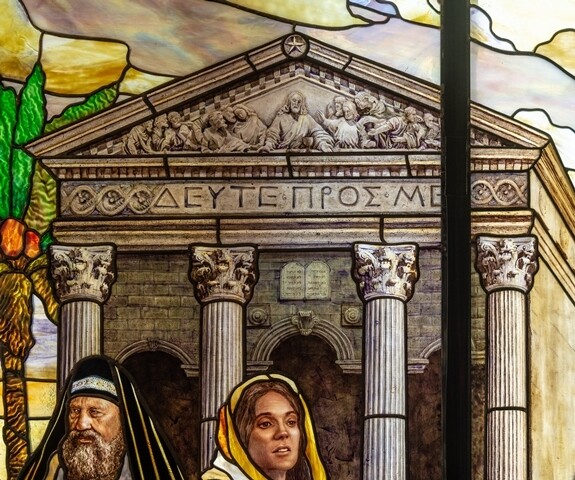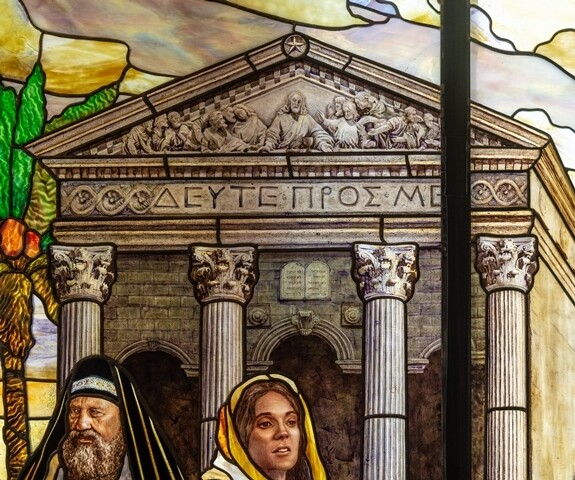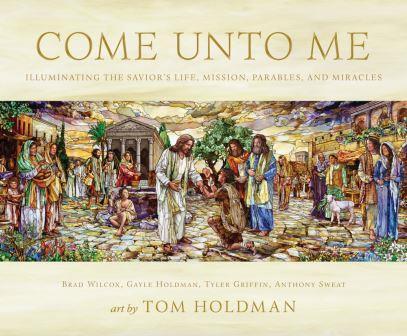Editor's note: This article was originally published in February 2019.
At the announcement of a temple to be built in Rome, Italy, there was an audible gasp throughout the Conference Center in Salt Lake City and, no doubt, in many chapels and members’ homes around the world. Such was the case in Tom Holdman’s home, where he literally jumped from his seat and exclaimed, “I will do that temple glass!”
After Tom was contracted to do the windows in the Rome temple, he was also commissioned to create a 20 by 7-foot window for the visitors’ center. This was to be the first image visitors would see as they entered the building, so Tom wanted just the right theme. Together with designers in the missionary department, Tom and his team brainstormed several options: Christ calming the sea, calling His apostles, healing those in need, and calling the children to come to Him. Each design concept was drafted, and the healing theme was ultimately chosen. Since this would be in the visitors’ center, Tom and the artists at Holdman Studios were encouraged to make the window a teaching tool as well as a beautiful piece of art. Leaders in the missionary department envisioned something that would be engaging for children and teens as well as for adults—something missionaries could use as they taught and viewers could return to again and again, discovering something new each time. With that goal in mind, the artists determined to depict—overtly and subtly—not only important aspects of Christ’s life, mission, and ministry but also all of His parables and miracles. The following are a few examples:
In the window, artists chose to represent Christ’s birth by placing a myrrh plant amid the other plants in the lower left-hand corner with actual chunks of frankincense interspersed around it:
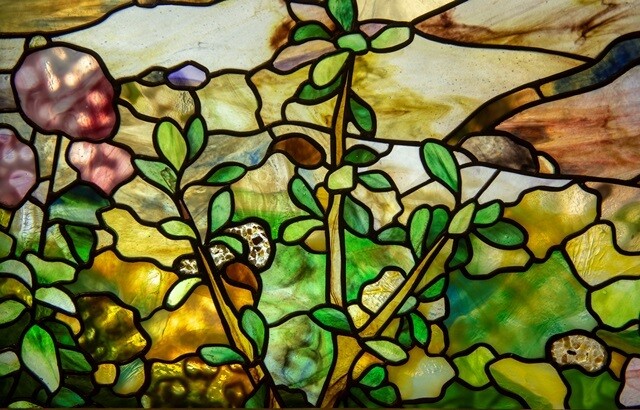
Gold is represented by the coin partially concealed under a stone by the foot of the beggar:
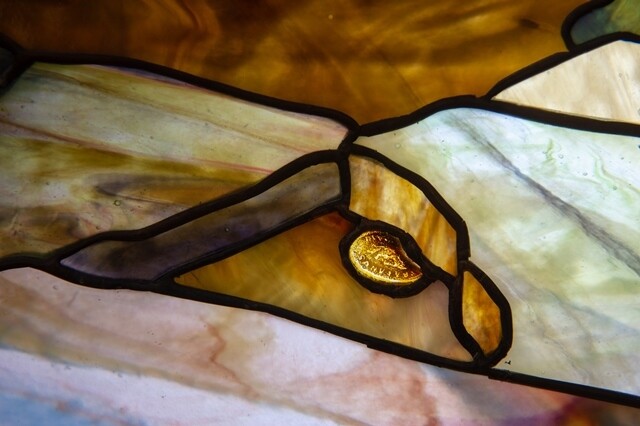
There is a carved star at the top of the building behind Jesus, and one sheep representing the shepherds who came to worship the newborn Lamb of God.
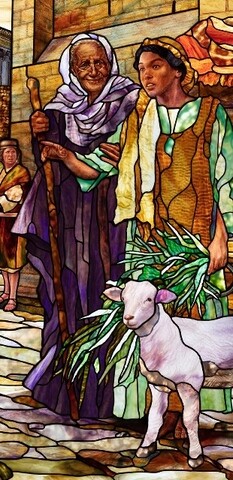
Additionally, viewers can find two turtle doves in the canopy-covered shop on the right side of the mural:
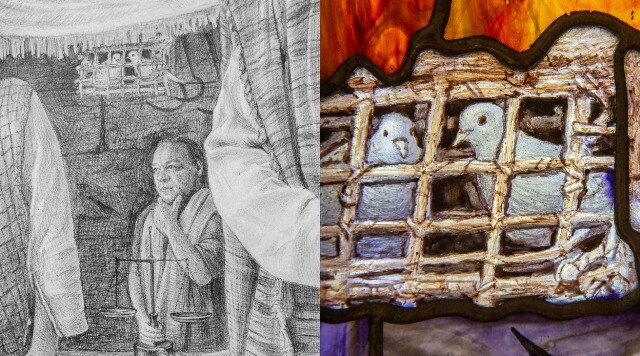
Joseph and Mary were so poor that they could not afford to sacrifice a lamb when the baby Jesus was presented at the temple. The Law of Moses made allowance for the poor to offer two doves instead of a lamb. Mary’s “Lamb” would be offered as a sacrifice for all, 33 years later. These symbols are easy to overlook when viewers first see the window, just as Christ can be easily overlooked—even by those celebrating Him at Easter and Christmas.
Fulfiller of the Law of Moses (Matthew 5:17-20, 23:1-12)
The leaders of the Jews repeatedly accused Jesus of not upholding or being loyal to the Law of Moses. Jesus responded by saying, “Think not that I am come to destroy the law, or the prophets: I am not come to destroy, but to fulfil” (Matthew 5:17). In the window, artists have shown two tablets carved into the stone on the large building directly behind the well:
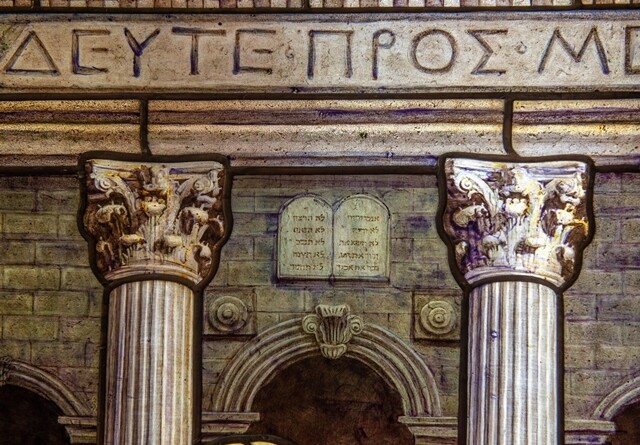
These are a representation of the two tablets that Moses brought down from Mount Sinai. They represent the commandments, but also all of the prophecies of the Old Testament prophets that were fulfilled in the life and ministry of Christ.
Champion of Women (Matthew 9:20-22; Mark 5:25-34; Luke 8:43-48; John 4:3-30; 8:3-11)
James E. Talmage declared, “The world’s greatest champion of woman and womanhood is Jesus the Christ” (Jesus the Christ, [Salt Lake City: Deseret Book, 1972], 475). The woman in the window next to the well represents three women in scripture. She is reaching out like the woman who touched Jesus’s clothes. She is wearing scarlet to represent the woman who had been taken in adultery, and she also represents the Samaritan woman at the well who heard Christ’s declaration that He is the living water.
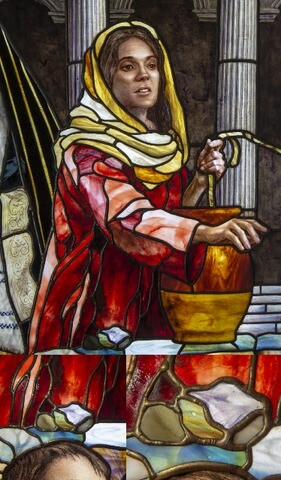
Although their needs and backgrounds were different, each was blessed by Christ’s power. They each allowed the glory of God to be made manifest in them. In front of the woman, on the well, are two stones (one is not glass, but an actual stone from the holy land), reminding us that the only One who was truly without sin cast no condemning stones.
Teaching Mary and Martha (Luke 10:38, 40-42; John 11:1-35; 12:1-8)
When Jesus was in the house of a friend named Martha, her sister Mary sat “at Jesus’ feet, and heard his word” (Luke 10:39) all the while Martha was “cumbered about much serving” (v. 40). In the window, Martha is represented by the woman at the far left. She has her hands full with the basket of food and tilts her head to the child clinging to her skirt.
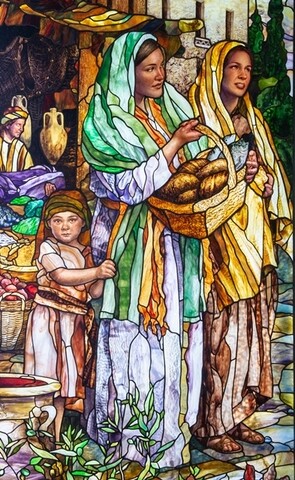
Artists have portrayed her as “troubled about many things” when compared to her sister Mary who stands next to her. Martha is focusing on the Lord, but she appears to be a bit distracted. Mary, on the other hand, has chosen the “good part.”
Gethsemane (Matthew 26:36-45; Mark 14:32-41, Luke 22:39-46; John 18:1)
Near the base of the Mount of Olives in the shadow of the Temple on the west side of the Kidron Valley, lies an area called Gethsemane, which means oil press. Jesus’s suffering in Gethsemane is represented in the center of the window. A large olive tree overshadows an olive press stone. This stone is a hauntingly beautiful symbol of the weight of the Atonement.
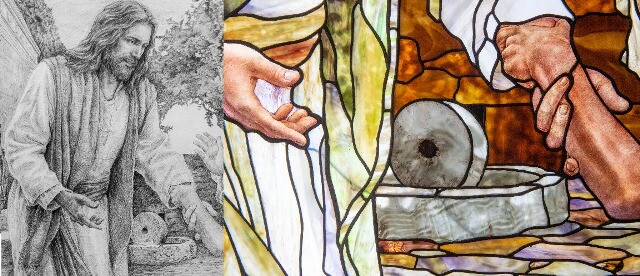
There are other symbols of the Savior’s atoning blood in the window. For instance, three crosses on a distant hill, and the grapes in the upper right-hand corner which are crushed to become the wine depicted in the bottom left-hand corner.
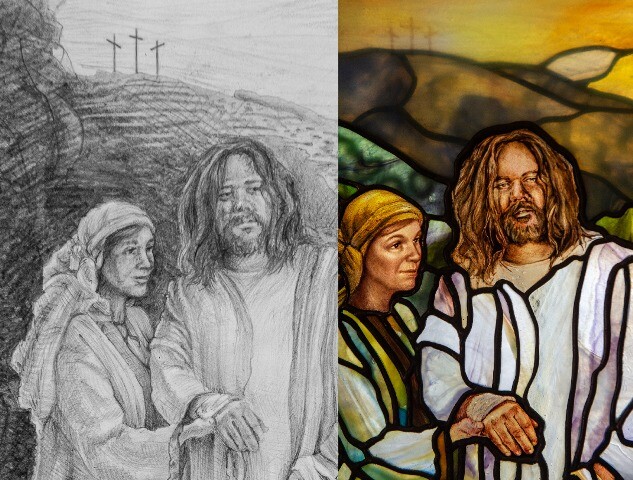

Between them, the viewers’ eyes cross through Christ, who “tread the winepress alone” (D&C 76:107). Behind the wine, onlookers will see a basket of pomegranates. Not only are they the same color as blood, they are also filled with life-giving seeds.
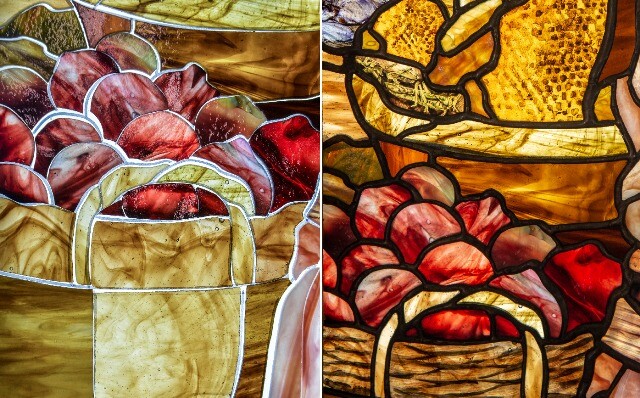
The Good Samaritan (Luke 10:25-37)
A lawyer asked Jesus, “What shall I do to inherit eternal life?” (Luke 10:25). The Savior told him to love God and love his neighbor. The lawyer then asked, “Who is my neighbor?” (v. 29). It was in answer to this question that Christ taught the parable of the Good Samaritan. To the right of Jesus in the window, viewers will see the Samaritan walking with the injured man lying across his donkey. It is as if he is walking him to the inn where he will pay for him to be taken care of.
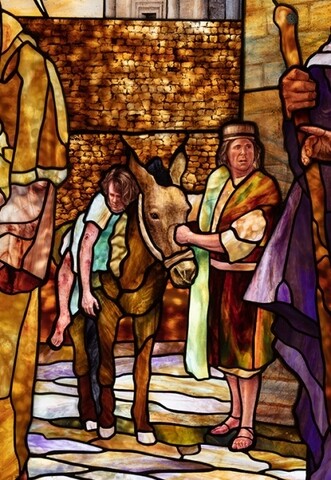
Wheat and Tares (Matthew 13:24-30, 36-43)
This parable is a powerful reminder of the opposition that always mounts against the work of the Lord. In the bottom right corner of the window, onlookers will notice a small cluster of wheat growing side by side with a few tares. As the two plants begin to grow, it is difficult to tell them apart. Once they mature, the head of wheat becomes increasingly bowed down, in humility, so to speak, with the weight of the grain but the non-consumable tares remain tall and proud.
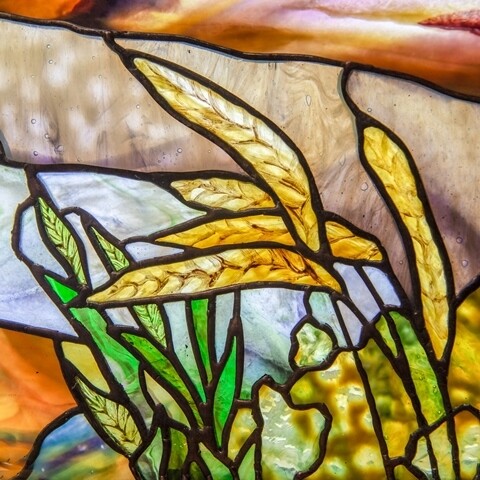
The Prodigal Son (Luke 15:11-32)
Imagine the hunger, pain, regret, and embarrassment the prodigal son must have felt on his long road home. “But when he was yet a great way off, his father saw him, and had compassion” (Luke 15:20). The fact that his father saw him so far away implied that he had been watching the road, tirelessly waiting for the first sign of his lost son’s return. Some parents would be furious at the boy for how he had treated them, but not this father; he ran to his child. He was not put off by his son’s deplorable physical condition. Underneath all the pig stench, the sweat and sores from an exhausting journey, and the stain of countless poor decisions, was his son. In the window, the prodigal son and his brother are depicted at the far right. The prodigal seems to feel the full weight of his many mistakes as he sits down on the ground next to a pig, while the other brother feels justified in condemning.
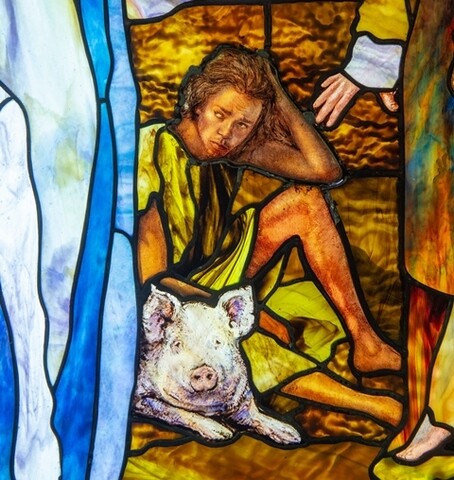
The Ten Virgins (Matthew 25:1-13)
Among Jesus’s most famous parables is that of the ten virgins. In ancient times, it was customary for a bride to wait for her groom with her bridesmaids attending her. When the groom arrived, the maids went out and met him with lamps to light the way, announcing his arrival. With this context in mind, Jesus was teaching about His Second Coming, saying, “Then shall the kingdom of heaven be likened unto ten virgins, which took their lamps, and went forth to meet the bridegroom” (Matthew 25:1). Five of them were wise and prepared while five were unprepared. The parable of the ten virgins is represented in the stained-glass window by the woman on the right holding her lamp, looking to Christ, the bridegroom:
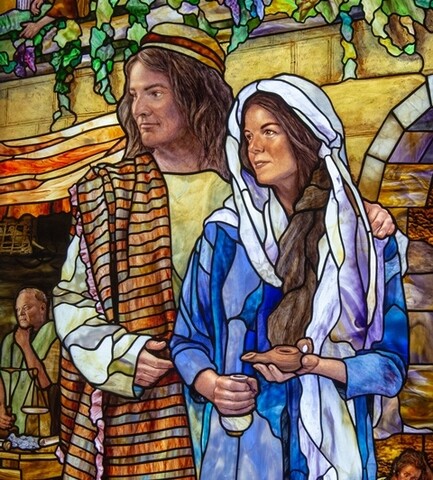
Not only does she have her lamp ready, she holds a small vessel filled with the oil of her righteousness, showing she is prepared to be in His presence.
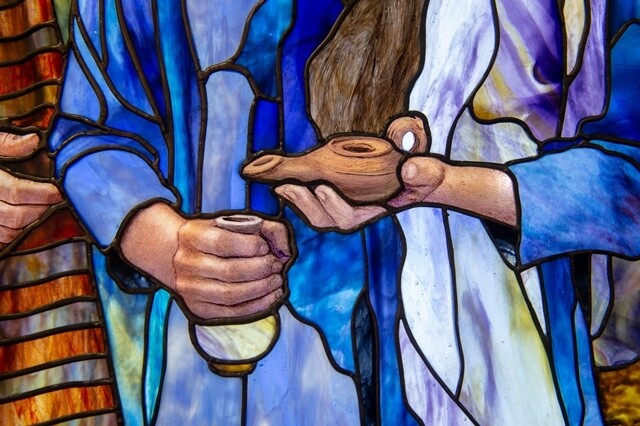
Water to Wine (John 2:1-11)
At a wedding feast in Cana of Galilee, the Lord turned water into wine. It was customary for Jewish people in this story to wash their hands before eating (see Mark 7:3; Luke 11:37-38), thus, this wedding celebration featured six large water pots of stone that were used for the “purifying of the Jews” (John 2:6). After dozens of washings, these would not be the vessels from which you would want to take a drink. Yet Jesus chose those murky, bacteria-laced, filthy waterpots for this miracle. Using His divine power, He turned water from those unclean vessels into the finest, best wine of all (see John 2:10). The miracle of water to wine is represented in the window by the large water-pot on the left filled with wine:
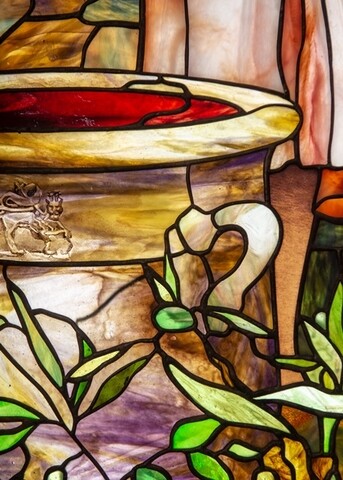
Jesus used the miracle of turning water into wine to send the profound message that He had the power to change the very nature of things—to transform not just the state of liquids, but the state of lives.
Calming the Storm (Matthew 8:23-27; Mark 4:35-41; Luke 8:22-25)
Jesus and His disciples were in a ship on the Sea of Galilee and “there arose a great storm of wind, and the waves beat into the ship” (Mark 4:37). The disciples panicked. The ship was filling with water, so they awoke the Savior, who was “asleep,” and cried, “Carest thou not that we perish?” (v. 38). The Lord arose and “rebuked the wind, and said unto the sea, Peace be still” (v. 39). Like storms on the Sea of Galilee, the storms of mortality are inevitable. But Christ cares and can help. Sometimes He calms the storms. Sometimes He calms us in the midst of the storms. Either way, it is miraculous. The artists of the window have hinted at storms as the sky becomes darker at the edges. They have symbolized the miracle of the calming of the sea with a toy boat and an actual shell from the Sea of Galilee next to the child sitting at the well:
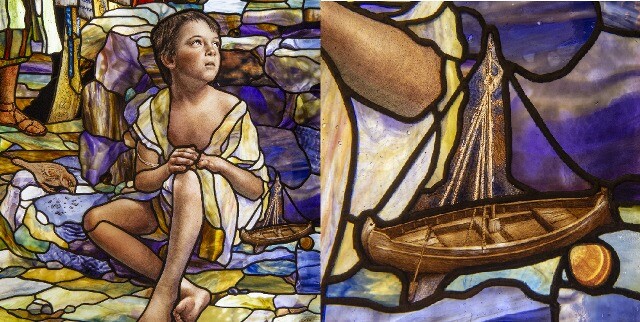
The healings of Jesus are the central feature of the magnificent piece of artwork found in the visitors’ center of the Rome temple. In the middle panel, Jesus reaches forward, grasping the arm of an infirm man, lifting him up with love. We see the skin of the young man closest to the Savior is clear and clean while the skin that is farther away is still covered with sores and dirt. It is as if we are witnessing the healing taking place right before our eyes:
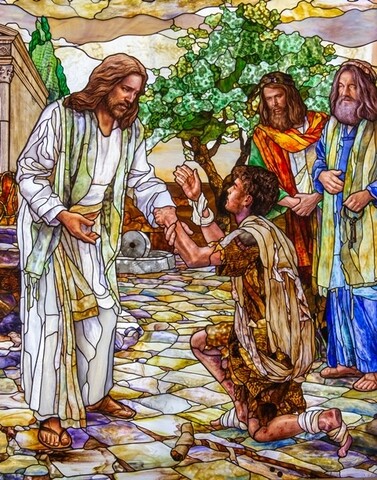
Some of the healings of Christ have been represented individually in the window, but this man represents all of the healings in the New Testament collectively. He is the lame, blind, leprous, deaf, dumb, infirm, and all those with any issues wrapped into one moment that symbolizes the miracle of healing. The man in the middle, wounded and suffering, looks up to Jesus with gratitude, healed internally and externally, made whole in every way.
Few looking at the stained-glass window in the Rome visitors’ center realize the work that went into creating it. But that is intentional. The artists never want the window’s individual elements to upstage the whole. The main goal is to focus visitors to the center on the majesty of Christ and not the complexity of the production. Some visitors will enjoy the piece as a whole while others will look closer and find deeper meaning throughout the window. One way or the other, it is the hope of Tom Holdman and his team of artists at Holdman studios that this window will illuminate the life and divinity of Christ in such a way that all who see it will desire to draw closer to our Savior and Redeemer. His love and grace are there for each. His teachings and miracles have not ceased, but continue to this day. Like the figures represented in this stained-glass window, each of us are in different places along the path of discipleship. We have varied situations, individual needs, and unique challenges as well as opportunities. No matter our circumstances, each of us can respond today to Jesus Christ’s loving invitation shown in Greek letters on the building portrayed in the window: “Come unto Me” (Matthew 11:28).
